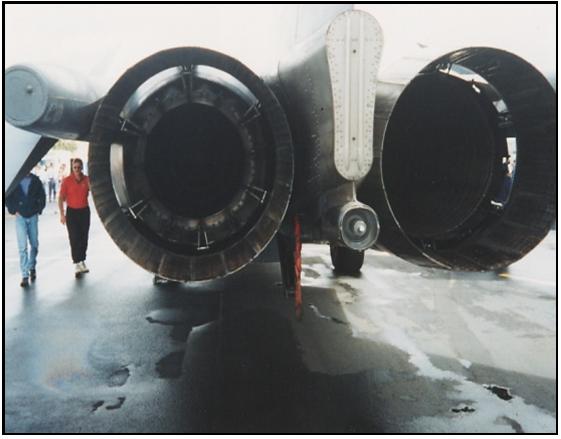|
RAAF Radschool Association Magazine - Vol 19
November 2007 Page 8 |
|
|
HAVE YOU APPLIED TO DVA TO DETERMINE YOUR QUALIFYING SERVICE ????
Some peop Remember, this form has nothing to do with the Means Test or your state of health.
DVA will then issue you with a number once your qualifying service is successfully assessed. This number is then your future reference for any application of Service Pension, a Disability Pension and/or health support related to your Qualifying Service. |
|
|
F111 Dump and Burn
The RAAF’s F111’s are always a big hit when they do their “Dump and Burn”, the noise, the light, the heat, it’s wonderful to watch, but how is it done?? We’re not too sure, but we think it’s done this way.
There are two ways of doing this, (1) fly around for a few hours and burn up the fuel in the engine(s) or [if fitted] (2) dump the fuel out the back of the aircraft by way of a fuel dump system. Although it takes longer, provided there is no danger that the aircraft can’t or won’t be able to maintain level flight, the first way is the preferred way. The second way is used when it is imperative to get the aircraft down on the deck ASAP.
The F111 has
a fuel dump system that sprays fuel out the back of the aircraft via the
dum
We don’t know whether General Dynamics designed the D&B into the F111 or whether it was something that was discovered by some young jock “stuffing around”. Whatever, it is an inherently dangerous thing to do, and completely unnecessary for almost any possible military purpose, outside of fantastic air show demos that is!!
If anyone has anything to add—we’d love to hear from them.. |
|
|
Women will never be equal to men until they can walk down the street with a bald head and a beer gut, and still think they are sexy. |
Smiths! A: They all have a telephone. Nelson! A: His last one |
 le
have not yet applied to have their Operational Service in Vietnam,
Malaysia or elsewhere recognised by the Department of Veteran Affairs (DVA).
The fact is that before a Veteran can receive support from the DVA for a
Service Pension or support for a health issue relating to their
operational service, the Qualifying Service has to be established. If you
are not registered with DVA, it is strongly recommended that you have your
qualifying service recognised now before a problem arises. In other words,
regardless of your current good health, your employment status, and,
especially if you are over 60, get the form
le
have not yet applied to have their Operational Service in Vietnam,
Malaysia or elsewhere recognised by the Department of Veteran Affairs (DVA).
The fact is that before a Veteran can receive support from the DVA for a
Service Pension or support for a health issue relating to their
operational service, the Qualifying Service has to be established. If you
are not registered with DVA, it is strongly recommended that you have your
qualifying service recognised now before a problem arises. In other words,
regardless of your current good health, your employment status, and,
especially if you are over 60, get the form
 An
aircraft has two critical weight measurements, Maximum Take Off Weight (MTOW)
and Maximum Landing Weight (MLW). Obviously, MTOW is always greater than
MLW. A lot of aircraft emergencies usually occur not long after take off
and if the aircraft is carrying maximum fuel (up near its MTOW), in an
emergency, in order to put the thing back on the dirt safely, it is
imperative that the pilot get the weight of the aircraft down to or less
than its MLW.
An
aircraft has two critical weight measurements, Maximum Take Off Weight (MTOW)
and Maximum Landing Weight (MLW). Obviously, MTOW is always greater than
MLW. A lot of aircraft emergencies usually occur not long after take off
and if the aircraft is carrying maximum fuel (up near its MTOW), in an
emergency, in order to put the thing back on the dirt safely, it is
imperative that the pilot get the weight of the aircraft down to or less
than its MLW.  p
nozzle. To conduct the D&B, fuel is dumped via the rear facing nozzle
where it immediately starts to vaporize on contact with the air. The
afterburner is then ’turned on’ and this ignites the vaporised fuel. The
flames actually start about 2-3 metres behind the aircraft as that is
where the best fuel/air mixture exists.
p
nozzle. To conduct the D&B, fuel is dumped via the rear facing nozzle
where it immediately starts to vaporize on contact with the air. The
afterburner is then ’turned on’ and this ignites the vaporised fuel. The
flames actually start about 2-3 metres behind the aircraft as that is
where the best fuel/air mixture exists.